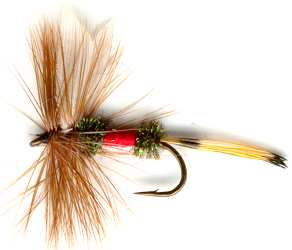The Royal Coachman Dry Fly
The Royal Coachman is an American trout flyfishing pattern that is the gaudy cousin of the British Coachman. When the Coachman wet fly crossed the Atlantic Theodore Gordon adapted it to a dry fly.

DRY FLY PATTERNS. Hook size 10 12 14 16 18 20 - $US each
In 1876 John Hailey, a professional fly-dresser living in New York, added the red silk band to create the distinctive feature of all Royal patterns. He had been asked to tie some extra strong Coachmen Dry flies. He tied a band of red silk in the middle to prevent the peacock bodies from fraying out. He had also added a tail of barred wood duck feathers. His dry fly has spawned a whole range of variants including streamers and hairwings. Mr L.C.Orvis gave it it's name whilst discussing with others what it should be called. He said "Oh, that is easy enough: call it the Royal Coachman. It is so finely dressed". Although the wings may vary, all have the same red central body section, butted either end with peacock herl. It often works when nothing else will.
The Royal coachman is an excellent general purpose up-winged dry fly that can be used to represent many other large winged insects as well as may flies. It is an ideal wasp, hornet or bee pattern. Treat with floatant and fish it on the surface. Try the occasional retrieve over the surface for a short distance or else twitch it to represent a struggling terrestrial insect like a wasp or bee trapped in the surface film.
Always try and get the leader immediately in front of the fly to sink under the water as this makes it harder for the fish to spot. This can make the difference between a blank day or one with lots of action. When putting on floatant make sure you keep it off the leader. This is a common mistake that can affect your fish catching chances. Degrease the front 10 inches. Do not try and fish this pattern downstream as it will drown. Fish it upstream and look in front of you for where the fish are rising for the natural insect. Be observant. If the trout start to dine on spent spinners rather then duns consider changing fly patterns.


Fly Fishing books

